DIY peacock gravel mosaic art

I started this gravel art project six years ago and finished it one year ago. I’m finally getting around to blogging about it. The project didn’t have to take five years to make, it just got set aside often to finish other projects, such as my kitchen remodel. It does, however take several days or weeks, depending on how many hours you put in each day.
Explaining the birth of this project requires a little back story. My grandmother had this exact pair of peacocks hanging on her living room wall. When I decided to remodel my kitchen and chose blues as my color palette, I wanted big, bold artwork on one wall that would coordinate with the blues. I immediately thought of my grandmother’s peacocks.
My grandmother died several years ago, and I didn’t know who in my family, if anyone, had ended up with them. I called my dad and asked if he had a picture of the peacocks so I could copy them. He said no, but then he told me the story behind them.

He said that he made them himself as a kid in the 1960s, when gravel-art kits were popular. They were also called crushed marble mosaic kits. You’d buy a kit, which included the pattern on fabric with a wooden backer board and side frames, cord, gems, and colored crushed marble to make the art.
I searched the Internet for examples of 1960s gravel art, and that’s when I found a picture of the same peacocks my dad made. You can still buy many of the vintage gravel art pieces made from these kits on Etsy.
Unfortunately, my grandmother’s pair of peacocks weren’t exactly as beautiful as a had pictured them from memory. Then I found this Joan Baker glass art panel online. It’s a popular stained glass pattern, and it was perfect. But it was way too complicated to make with gravel art (I didn’t want to spend five years making it after all, haha!), so I simplified the pattern.

The backing I used for this gravel art project has a story as well. The thin sheet of plywood was the original backing for this bookshelf that I revamped. My brother built the 1×2 wooden frame behind it to make a plywood “canvas” that I could paint to create a piece of artwork for my dining room makeover. I ran out of time to make it happen for that blog post, so the plywood canvas sat in my garage until this project came along.
I had to figure out how to make gravel art without a kit. I searched online and found SuZanna Anna’s video gravel-art tutorial (below) that appeared on HGTV. I followed her instructions step-by-step. I should mention that I recommend starting with a smaller, simpler design (like she does) instead of tackling something as complicated as this right out of the gate.
Then I went searching for tumbled glass suppliers, and I found aquarium glass in many different colors and sizes at American Specialty Glass. I bought all my glass from them. You can ask for samples before buying if you’re not sure of the color or size you want.
I found black nylon cording at Michaels, but discovered that 95 lb. parachute cord also works well. The yellow cord I used in this project is paracord.
Once I had my canvas, fabric, pattern, cord, and tumbled glass in hand, I got to work. Five years later, I finished it. I met my husband as I was nearing completion of the peacock. He helped me finish it (before we were married) and frame and hang it (after we were married).
From the beginning, I planned to frame it. I’d found Jon Peter’s video tutorial (above) for making simple frames for canvas artwork. I wanted the frame to match the custom wooden hood the my brother made and the matching wooden counter that my husband and I made for the peninsula in our kitchen. It took a couple tries, but I finally succeeded in matching the wood stain.
Supplies for making a peacock gravel mosaic
PEACOCK MOSAIC
DIY PLYWOOD CANVAS
DIY FRAME
PEACOCK PATTERN
INSTRUCTIONS

1. There are many ways you can build your own plywood canvas. This is how my brother did it. He built a 1×2 frame with a Kreg Jig the size of the sheet of ¼-inch plywood. Then he attached it to the plywood. I can’t remember if he used screws or wood glue and a nail gun to attach it, but either would work.
If you’re not worried about the overall weight and don’t plan on framing it, you could use a thicker piece of plywood and forego the support frame. But the glass alone makes gravel art quite heavy.
You could also use a thin sheet of plywood and, instead of a frame on the back, attach a decorative frame to the right and left side, like they did in vintage gravel art kits.

2. Paint the front and sides of the canvas white because the color of the wood can show through the fabric and make it look dingy. Even just one coat of primer or paint should do. I think I did once coat of primer and one coat of paint.

3. Print the pieces of the pattern on 11×17 paper and trim as needed for assembly.

4. Tape the pattern together.

5. Place the pattern underneath your fabric and trace the pattern with a pencil onto a piece of white linen. If you can’t see the pattern under the fabric, your fabric is too thick.

6. Center the fabric on the face of the plywood and glue it on. Glue ¼ to ⅓ at a time because the glue dries fast. Smooth the fabric down. You could use a brayer to help get it smooth.

7. Wrap the edges of the fabric around the outside of the frame and staple it to the back. Fold the corners as shown to keep the sides smooth. Cut off the excess fabric.

8. For the next several steps, it helps to watch SuZanna’s video I mentioned above, but also check here for some of my tips.
Glue the black cord along the lines of the pattern, one section at a time. Dab glue at the tip of each end of the cord to keep it from fraying. The cord is synthetic, so theoretically you could melt the ends with a lighter or candle instead. However, I discovered two problems with that method: (1) It’s doubly time consuming, and (2) melting invariably makes the ends thicker, which doesn’t look good in the design.
This is quite a tedious process. I finished an entire audio book (The Martian) while I was doing this.
Glue on each of the sapphire glass gems as shown.

9. Add the yellow cord in the spots shown. It doesn’t end up showing through much after you add the gravel, so you could just do black for the entire pattern. But I like how it adds slightly more yellow.

You could also use many differnt cord colors in this design than just black and yellow.

10. Transfer each color of glass to its own plastic bottle using a funnel. Label the bottles so you know what color is in each bottle (because some of them look very similar).

11. Fill in a few sections with glue that will be the same color glass. Spread the glue evenly with a wooden skewer.
Pour a heap of glass covering the glued sections. Pat the glass down gently, then poor off the excess. I found I had better results when I poured off the excess glass before it dried instead of after. That way, you have time to fill holes or fix overflows before the glue dries. And the process goes faster if you don’t have to wait for the glue to dry in between every pour.

12. SuZanna’s designs are small enough that she can use a cookie sheet to catch and reuse the excess glass. I couldn’t find a cookie sheet large enough for this piece (haha) so I slowly and gently poured it back onto the table, then swept it back into their bottles (using a funnel). Yes, small amounts of glass bounced to the floor, so you will have to thoroughly vacuum when the project is done.

13. Continue gluing and filling, one color at a time.
A warning here: Unless the specific type of glass says it’s tumbled, it does have sharp edges. Handle with care, and keep the artwork out of reach of small children. We explained to my husband’s kiddos (the youngest was 7) that the artwork on the wall had sharp glass, and they should not touch it. We’ve never had a problem. I prefer tumbled glass, but it is more expensive.

For gradient blends, pour glue just where you want the first color to go, fill with glass and knock off the excess. Then mix a small batch of two colors together, pour glue just where you want that mixture to go, and repeat. Then finish with the second color.
I was not satisfied with the blending results on my peacock. I may go back and fill in some spots to achieve a more seamless blend.

14. For the frame, watch Jon’s video tutorial or follow my instructions here. cut two pieces of wood the length of the canvas plus two widths of the wood frame (46½ + ¼ + ¼ = 47 inches). Cut two pieces the width of the canvas (27½ inches). Lightly sand all sides.

15. Apply your desired color of wood stain with a foam brush. See the directions on the can to know how long to leave it on.

16. Wipe off the stain with a dry rag until it’s clean.

17. Use a nail gun to nail each piece of the wood frame onto its corresponding side of the art.

18. Screw on two heavy duty D-ring hangers to the back frame, one on each side at the top. If you want to hang your art on a picture rail (like we did) or a picture hanger, attached a length decorative chain and hang it from a picture rail hook or picture hanger. Otherwise, attach the D-rings a little lower, and string picture-hanging wire between them to hang it on a nail.

Share this story
Reader Gallery
Made this project? Email your photo(s) to monica (at) craftynest (dot) com, and I’ll share your version here!

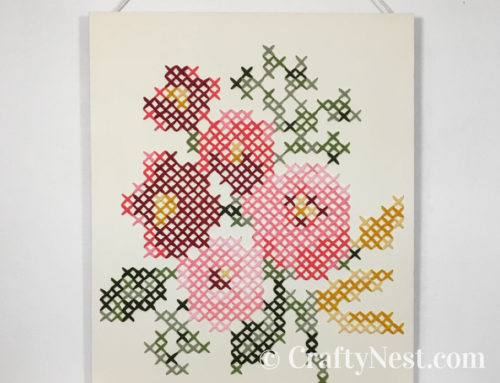
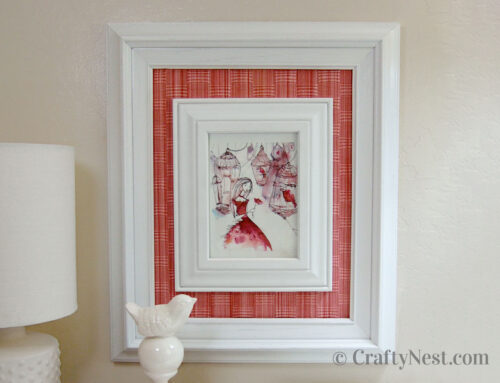
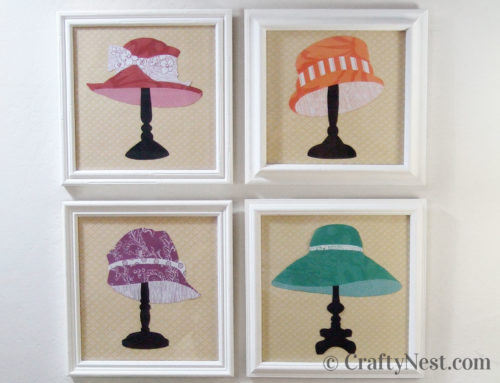
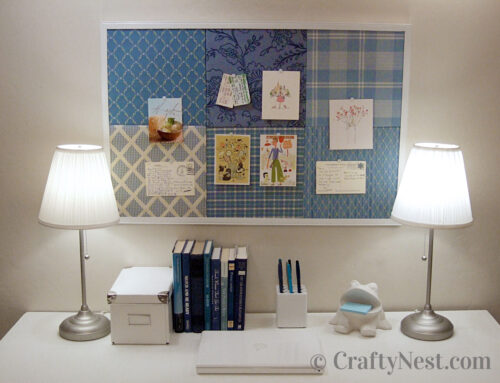
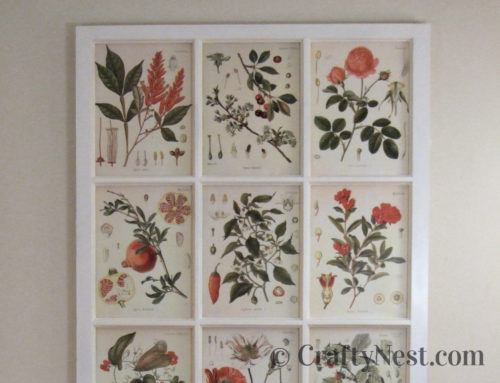
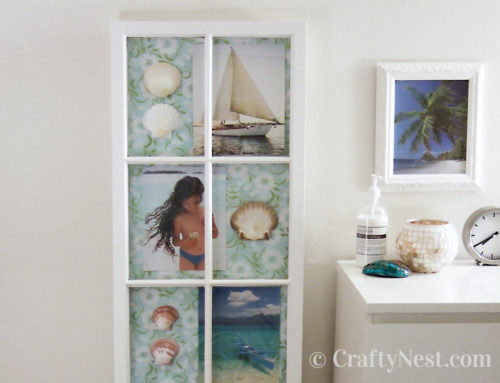
Leave A Comment